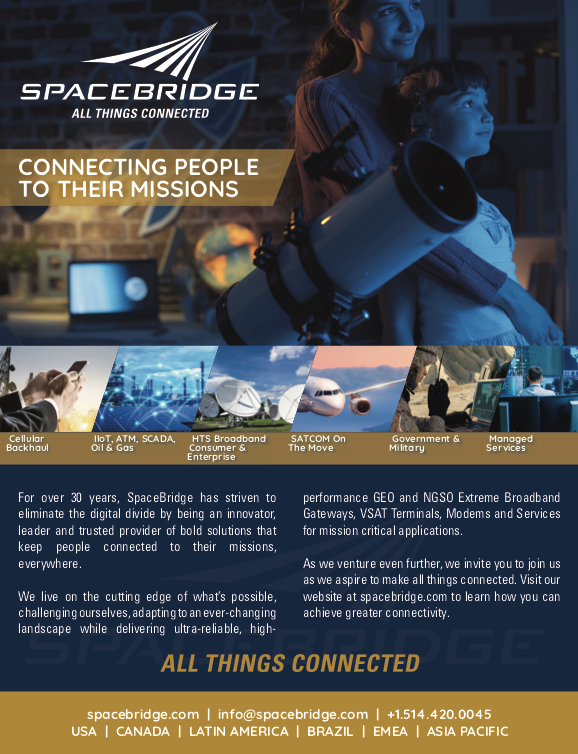Nomadic services provide portable, remote connectivity to virtually any location in the U.S., with the power and flexibility to support a single user or larger groups.
Nomadic services can deliver
internet on the fly.
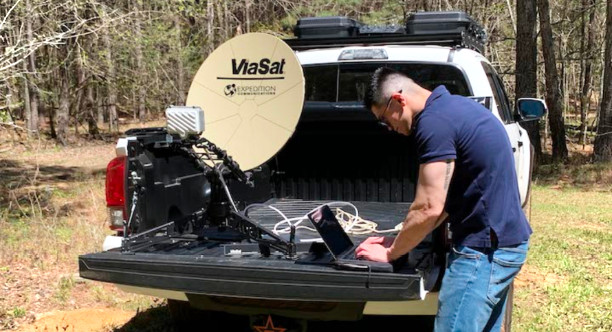
Viasat’s nomadic services may be one of the company’s lesser-known segments, but it boasts an impressive list of customers — from news and sports organizations to government agencies as well as a long list of other, high-profile events and organizations that rely on the portable technology.
Whether it’s broadcasting breaking news or providing communications during natural disasters, the service provides a reliable source of connectivity when other sources of power and connectivity are either down or — due to the remoteness of a location — not available.
“Cable and fiber lines can be accidentally cut, and cell towers can be knocked out by fires or hurricanes,” said Viasat’s Liz Parker, a business operations manager with the company’s Global Enterprise & Mobility segment, “and satellite can bridge the gap when these events occur.”
Viasat started the service in 2012 and plans to significantly expand it with the upcoming ViaSat-3 global satellite constellation.
What are nomadic services and why are they so important?
Introduction + Early Customers
Viasat developed the SurfBeam 2 Pro Portable system in 2012, introducing ground-breaking technology that served a long-unmet need for government and media markets. The 75 pound system could be setup anywhere within minutes, connecting to the ViaSat-1 satellite and allowing users to move to other beams, if needed.
A beam is a concentrated area of satellite signal strength, each one covering a particular geographic area on the ground.
“Nomadic services are an amazing application of the Viasat technology,” said Parker, who worked for the company when the technology made its debut. “When terrestrial infrastructure goes down, you can pop that antenna up, and the kit can roll from beam to beam. They can come up in most of our beams and be able to communicate.”
The kits include a dish, transmit-receiver (TRIA), modem, Ethernet router, battery pack, tripod and needed connector cables — all of which fit inside a suitcase-sized container.
Nomadic service users today get News agencies and government were among the first users of the technology. They saw its advantages clearly, with Viasat able to provide stable connectivity in typically unstable circumstances.
“We have plans that prioritize the return link (the link from a mobile user over the satellite to a fixed base station), which was very attractive to the satellite news gatherers,” Parker said. “Because they had priority in the beams, that created a reliable connection for a news reporter giving a live feed.”
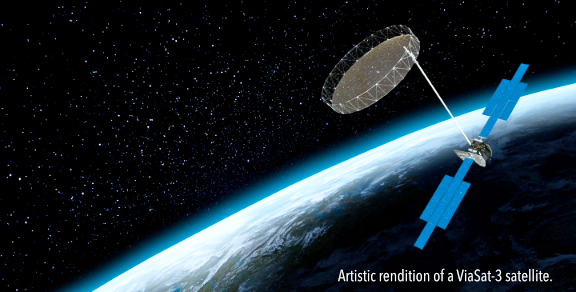
Designed To Fill A Unique Need
News companies remain heavy users of the service. Today, about 40% of Viasat’s nomadic services usage is by news agencies.
Viasat provides services to another rapidly growing customer called FirstNet, a nationwide wireless broadband communications platform for first responders and the public safety community. FirstNet is a public/private partnership between the First Responder Network Authority and AT&T.
FirstNet responds to a wide variety of incidents. Most recently, it sent two rapid deployable units to Boulder County, Colorado, to help with communications after the Marshall Fire, a December 30, 2021, wildfire that destroyed more than 1,000 homes.
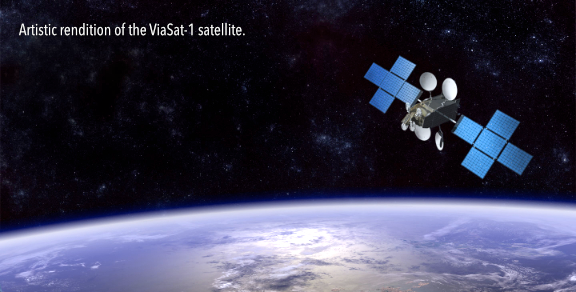
“It’s really satisfying to be able to provide communications when it’s needed in situations like that,” Parker said. “We know our firefighters and other first responders can communicate in those times.”
The Future
With Viasat’s current satellites, nomadic services can be used today across the U.S.; with ViaSat-3, it has the potential to expand across the globe.
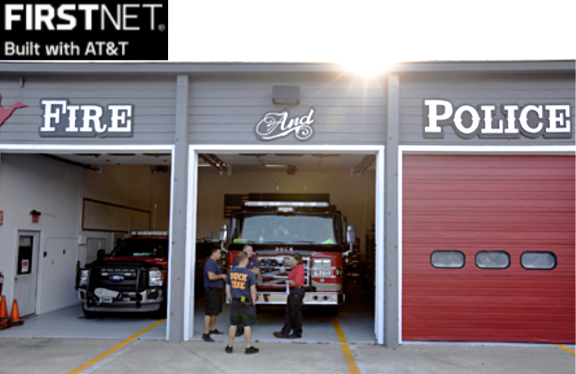
“Today, it’s a small part of what we do,” said Glenn Canales, business development manager for Viasat’s Global Enterprise & Mobility segment. “But management understands this is a service that is there for the public benefit. With that in mind, we’ve now redoubled our efforts to expand and grow these services. And with ViaSat-3, we should be able to grow that footprint internationally.”
Both Canales and Parker look forward to expanding the reach of nomadic services. Canales noted the growing need in natural disaster response alone.
“Both the intensity and duration of fire season grow every year, and hurricanes will continue to cause more and more damage,” he said. “Having served in the military and been in environments where there’s a level of criticality, I understand the need for communication. I’m definitely proud to be able to provide these services.”
Parker sees nomadic services’ future as virtually limitless.

“Nomadic services are a niche service, but a niche everyone can use at some point,” she said. “It’s incredible technology. It’s not just about satellite but about letting our users go virtually anywhere and have connectivity.”
Viasat.com
Author Jane Reuter is a marketing communications writer for Viasat.
Viasat’s IFC System Selected By Southwest Airlines For Factory-Installation On All New Aircraft
Viasat, Inc. (NASDAQ: VSAT) recently announced that Southwest Airlines Co. has selected the Company’s next generation, Ka-band satellite, in-flight connectivity (IFC) system to be factory-installed on all new aircraft deliveries, starting this fall.
By selecting Viasat’s industry-leading solution for its new aircraft, Southwest Airlines will provide customers enhanced internet capabilities while onboard, including the ability to stream content and entertainment, watch live television and access social media platforms and productivity applications on any internet-ready device,, gate-to-gate.
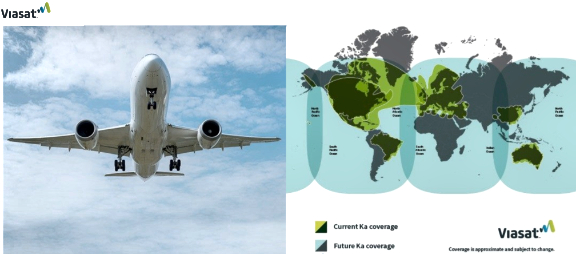
Streaming-capable Wi-Fi requires a fast and robust data connection — especially to deliver high quality service on all connected devices while in-flight, regardless of how many passengers are using the system.
Viasat technology solves a key challenge in providing high quality connectivity in aviation by addressing variable concentrated demand, such as many aircraft in the same geographical area – at airport hubs or traveling on popular flight routes. The bandwidth advantage and flexibility offered by Viasat’s satellite network provides a consistently high quality, high-speed, and content-rich in-flight Wi-Fi experience.

According to a January 2022 Sandvine Global Internet Phenomena Report, more than two-thirds of today’s internet traffic is driven by data-hungry video streaming or social media platforms. Viasat uses its current broadband satellite fleet, including ViaSat-1 and Viasat-2, along with its roadmap of satellites — including the ViaSat-3 constellation — to meet the ever-increasing demand for data-rich connectivity.
Viasat is a global communications company that believes everyone and everything in the world can be connected. For more than 35 years, Viasat has helped shape how consumers, businesses, governments and militaries around the world communicate.

Today, the Company is developing the ultimate global communications network to power high-quality, secure, affordable, fast connections to impact people’s lives anywhere they are—on the ground, in the air or at sea.


